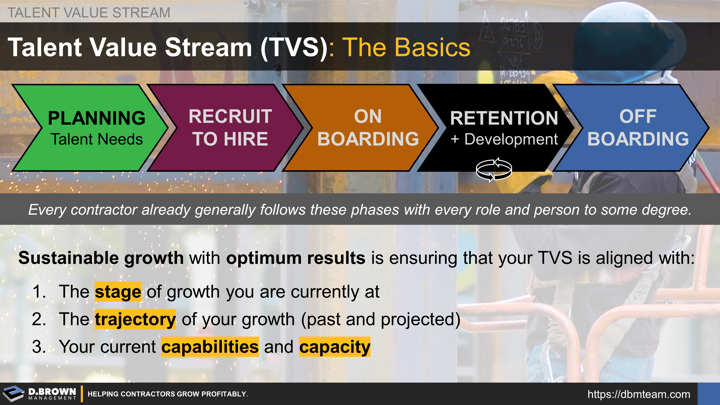The Talent Value Stream (TVS) is what enables every other part of the Contractor Business Model to scale with each stage of growth and evolving strategic market choices.
Every contractor already generally follows these phases with every role and person to some degree. With growth, each phase of the TVS must evolve, including tighter integration with the rest of the company.
- Planning for your talent needs. This starts out as very reactive at stages 1 and 2 based on project needs. By stage 6+ contractors have developed robust planning systems and pipelines for talent in all roles.
- Recruit-to-Hire including role clarity, recruitment marketing, and process to rigorously evaluate then select. At earlier stages of development, this is mostly about who you know and some simple job ads. By stage 6+ a contractor will have dedicated teams for recruitment marketing and recruiting along with a network of external resources. At the same time, their need for external talent will be lower as 80% of their roles are filled from internal promotions. Attracting and recruiting at the entry levels is easier because of both population demographics and the fact that you are hiring mostly for attitude and aptitude rather than for demonstrated capabilities built over 10+ years of experience.
- On-Boarding starts from the moment the decision to extend a job offer is made through the time the person is productively integrated into the role including having all the company-specific competencies required to be successful. With effective design of the role, selection process, and onboarding plan this will typically be anywhere from one week to one quarter depending on the complexity of the role.
- Retention & Development starts at the same time as On-Boarding and continues throughout their career. You must answer the same five questions continually for everyone on the team, not just during recruiting. Your answers must be better every year (progress) and at least on-par with what other options they have.
- Off-Boarding including terminations, resignations, reduction-in-force (RIF), and "Retirement On-Boarding" must be managed as rigorously as every other part of the process. The discipline for this usually starts around stage 5 of a contractor's growth. This includes feedback and continual improvements for all prior phases of the TVS. Structured programs for "Retirement On-Boarding" will help accelerate knowledge transfer and mitigate the worsening talent shortage in construction.
Like working through your Market Strategy, this is a highly leveraged activity and well worth having an experienced but unbiased third party facilitate the process.
The Talent Value Stream (TVS) is part of the Contractor Business Model, addressing all aspects of aligning people to support strategy and operations. The Talent Value Stream for contractors must evolve with each stage of growth.
Please contact us to learn more about our approach to helping contractors evaluate their Talent Value Stream in context of their strategies and business plans then developing an improvement roadmap.

